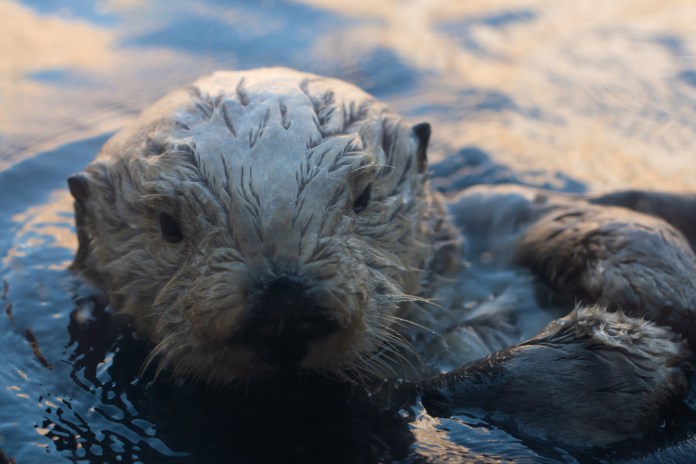During the last full week of September, Sea Otter Awareness Week was celebrated in honor of these furry marine mammals. The Monterey Bay Aquarium came together to celebrate this year’s 20th anniversary with The Marine Mammal Center, Defenders of Wildlife, Sea Otter Savvy and the California Department of Parks and Recreation. The event consisted of livestreams on YouTube throughout the week for viewers to learn about the conservation of California Sea Otters.
During the livestream “Marine Mammal Monday: Sea Otter Spectacular” on Sept. 19, the Marine Mammal Center’s Public Programs Coordinator Krystal Krucik spoke about the kind of work they do at their animal hospital. Their focus is on rescue, rehabilitation, research and release of not only otters, but also other various species of seals.
Did you know sea otters are more closely related to weasels and skunks than seals and sea lions?
Sea Otters are a keystone species, which means they have a large impact on their surrounding habitat and ecosystems. Without sea otters, sea urchin populations grow exponentially and wreak havoc on kelp, destroying the kelp forests. Kelp forests are the home to many creatures and are even a place for tired sea otters to raft together and rest. This is why these organizations work so hard to keep sea otters from extinction.
Ever since being hunted down to near extinction (there were fewer than 100 otters at one time), conservation efforts have successfully grown the population of sea otters in California to nearly 3,000. In the 1800s and early 1900s, sea otters were threatened by hunters who wanted their luxurious fur, but with the Marine Mammal Protection Act of 1974, hunting of sea otters has become illegal.
Today, sea otters population’s main threats include: maternal separation, malnutrition, disease, shark bites, oil spills and human interaction. When a sea otter pup is found stranded, they are sent to the Monterey Bay Aquarium.
Sandrine Hazan, the Stranding & Rehabilitation Manager from the Monterey Bay Aquarium, was invited into the livestream to talk about the aquarium’s unique Sea Otter Program. What makes their program unique is the work they do to rescue and rehabilitate sea otter pups with the help of surrogate sea otter mothers. Hazan described working with the pups to be “adorable and fun, yet challenging because each pup has their own personality.”
The surrogate mothers are able to teach their pups how to productively forage for food, use tools like rocks to open shellfish, groom themselves properly in the water and socialize with other sea otters.
When humans do need to interact with the pups, usually prior to meeting their surrogate mom, they take very specific precautions to keep the pups from imprinting or becoming attached to their human caretakers. They wear a black welding helmet, black poncho, and gloves to disguise the human figure. The outfit is often referred to as a “Darth Vader suit.”
Although they are cute, another key aspect of caring for the pups is not to speak to them. This further reinforces their mission, these animals are not pets and need to be set up for success in the wild where they will not have the help of humans.
The Monterey Bay Aquarium held a members only livestream, “Member Event: Aquarium Live” on Wednesday, Sept. 21 that gave members a behind-the-scenes view of the Sea Otter Program using pre-installed cameras. This opportunity is extremely rare because of the importance of preventing habituation and imprinting of the pups to humans.
Research Biologist Teri Nicholson shared some insider stories that many have never heard before. “When I first started, within a few years, Rosa was stranded as a small pup … at the time we just started to take care of them (pups).” She was raised as a pup and eventually released into the wild, but for the whole year she was out there, she was not the most successful. She had taken a liking to humans and was interested in them. She was recaptured by the aquarium and became an amazing surrogate mother for the program.
Nicholson also shared a story about the sea otter that started the program, Tula. Tula was rescued by the aquarium when they discovered she was pregnant. Unfortunately, she would have a stillbirth. Almost simultaneously, a stranded pup had been rescued. The people at the aquarium were able to gently remove the nonliving pup from Tula and slipped the stranded young pup into the tank where she quickly adopted it as her own. As the pup grew older, Tula stayed in human care permanently as a surrogate, while her pup was successfully released into the wild to live a happy life.
Rosa, Tula and Joy were the first generation of surrogate sea otter mothers at the aquarium. While Tula and Joy have now passed, Rosa recently retired and celebrated her 23rd birthday. Together the trio successfully raised almost 50 pups!
As Sea Otter Awareness Week comes to an end, those local to the coast reflect on the history of the California sea otter and remember to choose sustainable seafood and respect the nap, by viewing wildlife from a safe distance or respecting their nap time.

